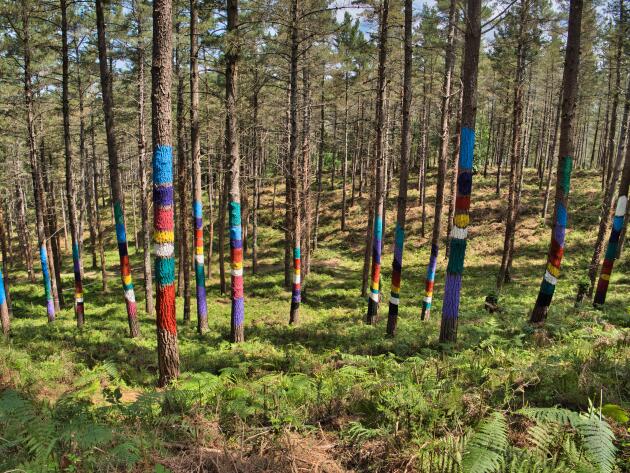THE MORNING LIST
A poetic forest, artist’s cabins where you can spend the night under the stars, a bucolic house, circles painted with gold leaf on the stones of a century-old abbey, ex-votos delicately placed on an oak… open-air works to discover at the detours of artistic trails.
In the Spanish Basque Country, the enchanted forest of Oma
Before being amazed, you must start by walking in the heart of the Oma Forest. The poetic work of Agustin Ibarrola is nestled in the Urdaibai Biosphere Reserve, in Biscay, a province of the Spanish Basque Country. Inspiration came to the artist when he retired from the world, near the village of Kortezubi, in the 1980s.
It was very close to the farm where he settled that he had the idea of painting the Oma Forest. A series of paintings on the trunks of around five hundred pine trees. Depending on the route taken or the direction in which we look, the figures traced on the trees assemble and recompose themselves, creating particular shapes, eyes, lightning, rainbows…
A living work struck by a disease which caused the death of the pines, taking with them the paintings made on their bark. In 2018, the forest is closed to the public, but a project to transpose the work located on the fringes of the original is carried out by the Government of Biscay and a multidisciplinary team. The new Oma Forestfaithful to the artistic intentions of Agustin Ibarrola, whose wish is for it to continue, should open at the end of November.
In the Hautes-Alpes, the Fairy Journey
On the way to the Crévoux valley, in the Hautes-Alpes, for another adventure, the Parcours des fées. A hiking trail where forty works are exhibited along a path between 1,600 and 1,900 meters above sea level. “We invite the artists to take a look at one of the components of the Alpine territory, the achievements are created in situ”, explains Erik Loré, the artistic director.
These creations contemporary artists question our relationship with nature and the rural world. As The Crying Houseby Argentinian Pedro Marzorati, a flooded and abandoned bucolic house which evokes climate change, or Lichensby Czechs Hynek Skotak and Tereza Hola, on a lawn, a flower bed made from plastic bottles, like an echo of the sixth continent, the mass of garbage that has accumulated in the North Pacific.
You have 64.32% of this article left to read. The rest is reserved for subscribers.
